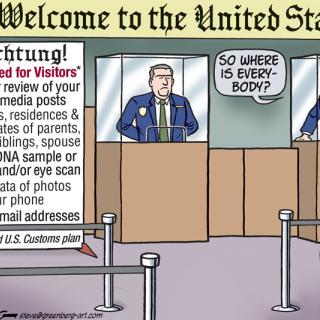There is no shortage of good journalism even in the profession's weakened state.
There is a shortage of people paying careful attention to what is happening around them and of people making intelligent, fact-based, well-reasoned decisions based on the news and information they consume.
And there is a shortage of those who can tell fact from fiction and who can process lies, exaggeration and opinion without being unduly swayed by them.
If everybody subscribed to the New York Times and looked at its print front page or its web home page on Saturday March 21 -- and took it seriously -- we would be well on our way to getting out from under the grip of the coronavirus pandemic.
A paid subscription was not necessary to read the Times's coverage online because the paper has made it free as a public service.
The Times published on page one in print and at the top of its news feed online three color-coded maps of the United States based on information supplied by two Columbus University researchers, Sen Pei and Jeffrey Shaman.
The top map shows the level of the coronavirus outbreak on July 1 if "no restrictions" on public life are undertaken. Almost the entire map is dark red, indicating that 75 percent of the country would be infected. Central Ohio and all of Ohio are blood red.
The second map depicts the level of outbreak on July 1 with "some control measures" and some social distancing having taken place. The Columbus region is light red, indicating a 5 to 25 percent penetration rate. The Cleveland and Cincinnati regions are a darker hue of red, indicating a 50 to 75 percent penetration rate
The third map shows the level of outbreak with "strict nationwide curbs" on people gathering that cause people to stay at home. The Columbus, Cleveland and Cincinnati regions are nearly all white, indicating a coronavirus penetration of less than 1 percent. A few parts of eastern and western Ohio have a penetration rate or 1 to 5 percent.
A deeper dive into the article in The Times offers graphs of all 50 states and suggests that Ohio Gov. Mike DeWine's early imposition of control measures, compared to many other states who leaders were less aggressive, will likely result in Ohio's curve of infection rates being flattened sooner rather than later.
Even in 2020, the New York Times drives the news agenda for other news media. While some news media pay The Times for using its content, others copy, summarize (such as I have), paraphrase and rewrite the bellwether's content within copyright limits.
If the details of The Times's stunning graphic portrayal of the health and safety challenge confronting us were widely disseminated not only to those who normally pay attention to the news, but also to those who only pay little or no attention when the news directly affects their lives, sadly a growing number, we would be in much better position of upending the coronavirus.
If people take this information seriously, they will pursue the necessary corrective action, quarantine themselves and their loved ones at home, practice social distancing and up the hand-washing, hygiene, sanitation and elbow-bumping.
If people quickly change their ways, we will get out of this horrible woods by the middle of summer and maybe sooner.
But there is other communication out there that argues for people to ignore or downplay the pandemic:
- It is a hoax.
- It is an attempt to undermine President Trump and defeat him for re-election..
- It is Fake News.
- You can only trust Fox News.
- Drugs we now have, like z-packs, will cure it.
- It is a socialist plot.
- It is the Chinese flu.
The phony baloney goes on and on. Its net effect is to distract people from the truth and keep them from taking the action that will eradicate the virus and let us return to our normal lives.
HBO is now airing a documentary, called "After Truth: Disinformation and the Cost of Fake News," that shows how fringe media are telling lies and making stuff up to the detriment of our society.
It tells of the phony story concocted by wacky commentators of a portion of rural Texas that was the scene of a U.S. Army drill. People were misled that the drill was part of President Obama's plan of rounding up and imprisoning dissidents who opposed him. A town meeting had to be held to dismiss the rumors to a largely suspicious crowd.
And the documentary tells of Pizzagate, where a militant dissident was so convinced by the crazy media talkers that a Washington, D.C., pizza restaurant was housing a pedophilia ring that he stormed and shot up the place before being arrested.
People not paying careful attention who believe phony reports, such as shown by HBO, imperil our future way of life in the vortex of the coronavirus pandemic.
(Please send your comments and suggestions for future columns to John K. Hartman, ColumbusMediaInsider@gmail.com)
(ColumbusMediaInsider, copyright, 2020, John K. Hartman, All Rights Reserved)



